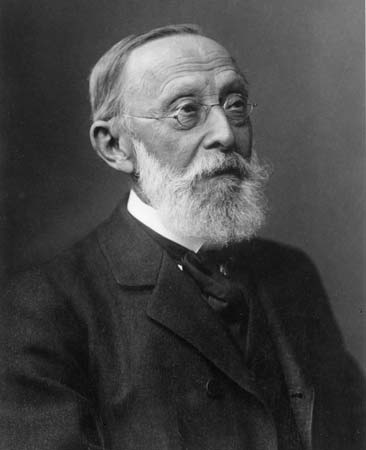Historically significant collection of pathology and anatomic specimens may fall victim to budget cuts and space constraints
Pathologists across the globe will be interested to learn that the pathological-anatomical collection of the famous Doctor Rudolph Virchow, housed for almost 100 years in Berlin, may soon be closed to public viewing. Administrators at Berlin’s Charité Hospital are threatening to shut down what is often recognized as the world’s first pathology museum.
Virchow’s collection is currently on view at the Berlin Medical Historical Museum (BMHM), which is managed by Charité Hospital. It was reported by Der Spiegel, one of Germany’s widely-read news magazines, that Charité’s administrators are looking at “options for such ‘future development’ [that] include ‘shutting down the museum’ and ‘moving the collections to other museums.’”
In its coverage about this story, Der Spiegel noted that the proposed closure threat comes even though the BMHM has been relatively successful. It attracts an average of 120,000 visitors each year since the installation of a forensics show in 2009. Ticket sales cover about 30% of expenses.

Dr. Rudolph Ludwig Karl Virchow (1821-1902) was a German physician. He is commonly called “the Father of Modern Pathology.” Virchow is also considered one of the founders of social medicine. His world famous collection of pathological and anatomical specimens, currently housed in a museum managed by the Charité Hospital in Berlin, may soon be closed to the public because of budget and other operational issues. (Photo by Wikipedia.com)
Charité is one of the largest university hospitals in Europe. It has 3,800 doctors and scientists and 13,000 employees. There are four campuses and more than 100 clinics and institutes. Charité’s annual revenue exceeds €1.2 billion. More than half of Germany’s Nobel Prize winners in medicine and physiology have come from Charité.
Unique Collection Traces Roots of Disease and Anatomic Pathology
Anatomic pathologists and clinical laboratory managers are familiar with Virchow, who is considered the father of microscopic pathology. He lived from 1821 to 1902. Besides his career as a physician and pathologist, he was also an anthropologist, biologist, pre-historian and politician.
He founded the medical fields of cellular pathology and comparative pathology. He is known for encouraging medical students to use microscopes and to “think microscopically.”
An impassioned advocate for social and political reform, Virchow also contributed greatly to the advancement of public health. His innovative Virchow autopsy method remains the technique of choice for many pathologists, particularly in forensics.
In 1856 Virchow became director of the newly created institute of pathology. By 1890 he had expanded the museum’s original collection of around 1,500 specimens to some 19,000 specimens.
Der Spiegel Characterizes Virchow’s Pathology Collection as “Ghoulish”
Pathologists and medical laboratory managers may be interested to know that Der Spiegel characterized the Virchow-BMHM pathological-anatomical collections as a “cabinet of horrors” and “ghoulish curiosities.”
Given Der Spiegel’s assessment of his collection, a glimpse at the world of Virchow’s time may be useful for historical perspective on the magnitude of his contributions. A German national, Virchow was born in 1821. The same year, Napoleon died in exile on Saint Helena. In Germany Beethoven, deaf and ill, was still composing music.
In the United States, James Monroe was President and settlers began the first colonies along the Santa Fe Trail. In Philadelphia, the College of Apothecaries opened the first pharmacy college, and Kentucky abolished debtors’ prisons.
As reflected in his meticulous collection and his contributions to pathology, medical science and public health, Virchow was a man ahead of his time. The BMHM website states that Virchow wanted to meet two goals with his collection. First, he hoped the collection would advance the general public’s knowledge of health and illness. Second, he wanted to document every known disease in a way that would reflect each disease’s characteristic development.
Der Spiegel described the Virchow-BMHM collection as perhaps “the creepiest part of [Berlin’s] rich cultural landscape.” Virchow considered health and illness an important part of human culture. Notwithstanding the fate of the Virchow-BMHM collection, given his renown and the contributions he made to the field of pathology, Virchow’s intentions speak for themselves.
Virchow’s contribution to pathology and medical knowledge were affirmed in the words of the 20th century American pathologist, Dr. Edward A. Gall (1906-1979), who was the Editor-In-Chief of The American Journal of Pathology from 1957 until 1966. In reference to the value of the autopsy, he stated the following:
“Despite the disparagement of the ignorant and the patronizing smiles of the sophisticated, the necropsy still moves along at its time-honored, steady pace, maintaining standards, contributing to knowledge and even, on occasion, stimulating the sluggard.”
—Pamela Scherer McLeod
Related Information:
Berlin’s Cabinet of Horrors: World’s First Pathology Museum Threatened with Closure
Berlin Medical and Historical Museum




Such a shame that people see this important contribution to mankind’s knowledge of Pathological Anatomy and the developement of disease as “creepy” or “goulish”. This serves to highlight the general public’s ignorance of important facts affecting their well being.
The University of Vienna also has a wonderful collection of medical historical exhibits in the “Josephineum” Museum on Waeheringer Strasse. Also, there is the “Pathological Anatomy” Museum in the “Narrenturm” of the old Vienna General Hospital (Altes AKH der Stadt Wien) which houses many of Karl F. von Rokitansky’s specimens, much like those of Virchow.